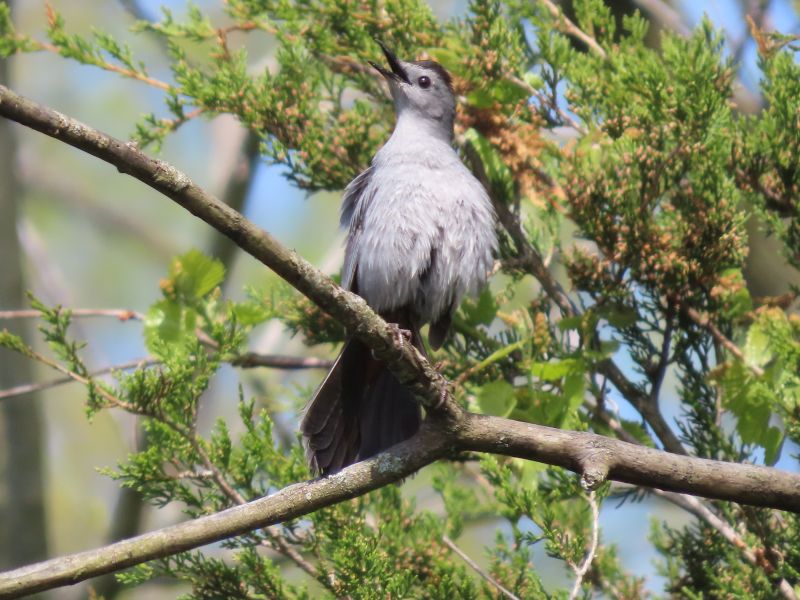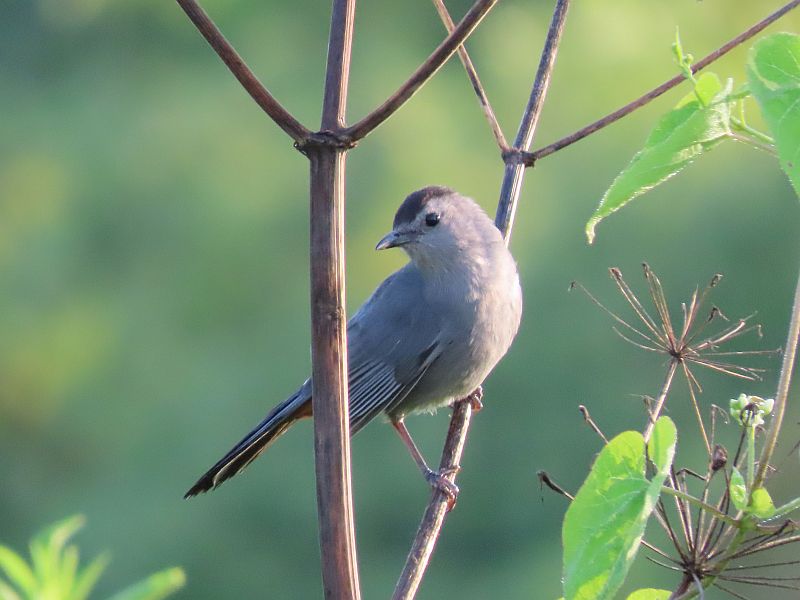This is one of my favorite birds here in Ohio (OK, I have a lot of favorites). Find out why by reading this post!
This bird’s full name is the Gray Catbird. It is a robin-sized bird of the Mimid family (joining such songsters there as Mockingbirds and Brown Thrashers). Its Latin name roughly translates into ‘small thicket dweller’ and this name fits this bird very well- you most often will see this bird in thickets, especially along wood edges. In North America it lives east of the Rocky Mountains, and usually migrates for the winter to the southeast or Central America or the Caribbean.

Three physical traits immediately catch your eye when you see this bird. Its color is slate-gray, which makes it fairly unique-looking. Another trait is its black cap. And lastly, you may notice its rufous undertail coverts (the place where the belly joins the tail).

Catbirds are usually easy to identify because of these visual traits. They are also unique in the sounds they make.
‘Meow’
Since they are Mimids and related to Mockingbirds, if you guessed that they imitate other birds, you are correct. Their song can go on for several minutes, though unlike Mockingbirds and Brown Thrashers, they don’t repeat the same song part or phrase, they just sing on and on. This gives their songs a squeaky quality. Not to put down our Catbird friends, but Mockingbirds seem to be much more accomplished mimics! Both males and females sing, by the way.


Catbirds sing both from exposed perches and inside thickets. They put a lot of enthusiasm into their verbalizations.
Speaking of verbalizations, their common call sounds quite a bit like…a cat (so that’s where the name comes from!). This ‘meow’ call often is given when these birds are disturbed by something- say a birder like me walking by their territory. Just two days ago I heard over 20 of these birds on a nature walk.
Catbirds are rather common when it comes to numbers (one organization estimates there are 29 million individuals of this species). But if you haven’t seen lots of them, it is probably due to their particular fondness for thickets and shrubs. They are similar to Cardinals in this regard. They nest in such places close to the ground. But keep your ears open, you may hear them calling or singing, even in the suburbs. I have one that I hear in the area where I live. The abundance of thicket environments is probably related to their numbers, since humans tend to encourage this habitat (clearing areas for building encouraging this growth…also abandoned farms).
One of my favorite Catbird stories comes from a Metro Park I walked at called Glacier Ridge. There was a vernal pool inside a copse of woods, and a Buttonbush that was right next to the path on this spring day. It was a place I often saw a Catbird in. I mused that I should be seeing them again soon, and as soon as I thought that, a Catbird- the same one?- stuck its head out of the Buttonbush and meowed at me. It (or they) loved that bush.

Photogenic
One of my favorite things about this species is the dramatic poses they often strike.


Sometimes they pose while looking intently at you, sizing up any threat you may be. Or perhaps they are curious. I’ll often see them on the grass next to a path foraging (reminding me of Thrushes and Robins doing the same thing). One thing for certain- if you come into their territory they will start ‘meowing’ at you!


When it comes to food, Catbirds eat roughly half their diet in insects and the other half in fruits and berries. It’s good to eat both so one’s chances of running out of food are reduced. When I see a patch of Wild Grapes like in the above picture, I often see Catbirds hanging around snacking. They also eat Poison Ivy berries too (don’t try this at home, readers!). The occasional Catbird will stay north halfway through winter if it has plenty of berries and water around. Thickets and berries go together, so these birds have a good thing going for them.

In the summer you will often see young Catbirds like the above picture shows. They have yellowish mouths around their beaks and may behave differently than adults. The above bird was quite curious about who I was and what I was doing. I’m sure wherever this bird is now, it is meowing a lot!
And now, I leave you with one last picture I took of a curious Catbird, wondering who is disturbing them in their wonderful thicket.



In recent years it’s seems that catbirds have displaced mockingbirds in a number of central Ohio locations.
That’s interesting, Bob and Donna! Catbirds certainly outnumber the Mockingbirds by far. I’m guessing humans have created more of the environments that Catbirds enjoy living in…
Thanks for another beautiful post about one of my favorite birds as well, Tracy!
Many thanks to you for reading, Kitty!
An informative post with excellent illustrations, Thank you.
Thank YOU for coming by and reading, Tootlepedal!
A pleasure.
Tracy, great post and wonderful photos as usual! Always enjoy your posts.
Many thanks John! Glad to hear from you!